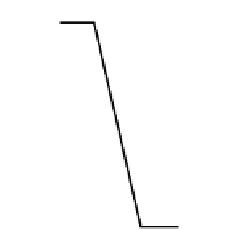Information Technology Reference
In-Depth Information
T
stay
i
T
change
i
1
1
0.8
0.8
0.6
0.6
0.4
1
0.2
0.5
0
0
0
0.1
0.2
0.3
0.4
0
0.1
0.2
0.3
0.4
d
i
(s)
d
i
(s)
Fig. 11.2
Temporal conditions for the state
q
i
Output Vector (
Y
)
Y
is the output vector:
, with
n
y
being the number of output variables.
Y
is a summary of the characteristics of the system evolution that are relevant for
the application.
(
y
1
,
y
2
, ...,
y
n
y
)
Output Function (
g
)
The output function (
g
) calculates, at each time instant, the next value of the output
vector:
Y
[
t
]=
f
(
U
[
t
]
,
S
[
t
])
.
11.2.3
Fuzzy Finite State Machine for Gait Modeling
This section presents the design of the main elements needed to build a FFSM to
model the human gait.
Fuzzy States (
Q
)
As stated in Section 11.2.2, every state represents the pattern of a repetitive situation.
According to the diagram at the bottom of Fig. 11.1 and using our own knowledge
about the process, we define four different fuzzy states which explain when double
limb support, right limb single support, or left limb single support are produced.
Therefore, we easily define the possible set of fuzzy states as follows:
•
→
q
1
The right foot is in stance phase and the left foot is in stance phase (double
limb support).
•
q
2
→
The right foot is in stance phase and the left foot is in swing phase (right
limb single support).






































































































